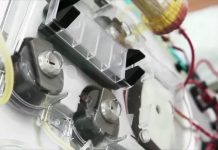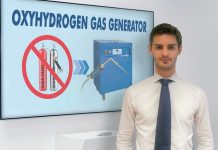Consolidating the position of BSH brands in the top and premium segments is the goal set by the company for the future. Among the instruments deployed to hit this target there is a new modular oven architecture, which integrates steam and microwave cooking and has required an accurate study of all components.
Last September, BSH introduced an all-new oven platform under the labels Bosch Series 8, Siemens iQ700 and the new premium ovens from Neff. For Bosch and Siemens the ovens were by far the most important news at IFA Berlin, to much acclaim among customers, colleagues and press. It was the largest product development program in the history of the company, with 130 developers and 21 new technologies. BSH currently produces 2.1 M ovens yearly, and 1.2 M will be of the new platform.
It was time. Competitors AEG and Miele renewed their product palette with much success, and many were expecting Munich to make a move. And they did. And how? They integrated steam and microwave in the conventional oven format, and provided fully automatic recipes for all possible combinations. That is really unique and the competition will need a lot of effort to match these features.
Of course, this is big news, and HAP&C travelled to the BSH development center in Traunreut, in the picturesque Bavarian landscape, between Munich and Salzburg. There a team explained all the backgrounds on the project. Your correspondent was reminded of why doing business in Germany is such a pleasure: everybody was competent, fully informed, motivated and open for additional opinions.
The main target of the project, in marketing terms, is to strengthen the strong position of BSH brands in the upper and premium segments. The new features and all their combinations will allow for a broader product palette, within each brand but also among the brands.
As said, the integration of microwave and steam functions in a standard oven, as well as the integrated automatic functions are the main features of the new platform. From customer research BSH found that speed is an important requirement. At the same time the trend to spend more time on cooking (especially in the weekend) makes the consumer more quality-aware; here the need for added taste of steam. And at the same time BSH wants to offer pyrolytic cleaning on most models.
To make adding microwave and steam functions easier for the customers the BSH cooking specialists developed variations on existing recipes for the new hardware combinations, and added them to the oven software, which is also accessible through an app as well as a dedicated cookbook, tailored to your specific oven type. The recipes cover a broad range and are mainly designed to show the user how to use the additional functions. BSH spared no efforts: all oven types have their own cookbook, where all options of combined use are explained. At the moment, there are more than 500 oven types, for three brands (Siemens, Neff, Bosch), involving a relevant design and productive effort. Most of the cookbooks are free for owners of the new ovens but you must order them separately.
As an example, let’s look at three automated recipes for grilled chicken. The basic recipe uses hot air grilling at 200°C, and takes about 50 minutes. Using the microwave function at a 360 Watt setting, and a hot air temperature of 210°C, it takes only 30 minutes. The combination with steam will be 200°C in 4D hot air circulation, with added steam at setting 2, for 15 minutes, followed by 35 minutes of hot air grilling at 200°C.
It might seem an enormous task to develop all these variations, but the specialists explained that mainly existing recipes were used, and because the cooking specialists are not just experts in excellent cooking, but also have a greater knowledge in food physics there is a great know-how on recipes which made designing microwave- and steam variations relatively smooth.
To incorporate all this new hardware, a whole new oven platform was needed. It was quite a challenge to fit everything inside normal measurements. What about the components? The microwave unit was redesigned from the ground up together with Asian suppliers, as there is no microwave component manufacturing in Europe. The new unit is smaller than before: it is designed as an adaptive module with strong focus on the size, caused by extreme limitations on the built-in-space for these components. This is mainly guaranteed by using new generations of power electronic components, without losing performance or maximum power. So in a 60cm full-size oven, you can realize up to 900W microwave power. There is no other appliance like that available on the market.
The steam unit is an in-house development. BSH started manufacturing its own steam ovens a decade ago, and the same development unit at the BSH plant in Bretten (Southwest Germany) designed the new unit. One has to remember that there are two types of steam ovens: full steam, where all the heat is transferred by the steam, and additional steam, where the steam is, you guessed it, additional to the normal heating systems. A full steam oven uses a lot more water and will have more condensation inside the cavity, needing a different design. The new platform supports both types, additional steam and full steam. The water tank is hidden behind the control panel, which swings upward. Other innovations regarding the steam unit are the surface heating element that allows a fast and sensible controlled vaporization, the reduced size of pumps and heaters and some sensors, which allow the consumer to get some nice information about the process and a comfortable communication with the oven interface.
For further automation the software needs more parameters. The probe (for meat) now has three sensors and uses the lowest measurement. The probe is often misplaced and then underestimates the temperature. Completely new is the baking sensor. During testing BSH found out that when the moist production of your cake goes down during the baking process, you have to lower the temperature. But how to measure this? There are no moist sensors that can meet the requirements of an oven with pyrolytic cleaning. Further research showed that the oxygen level is reverse corresponding with the moist level, and now a standard lambda sensor from sister company Bosch Automotive is used. It contains a ceramic material that becomes sensitive to oxygen levels after being heated.
Then a new fan was needed. For a good air flow, the speed must vary, and the direction needs to be reversible. Everybody was surprised that there were no small direct-drive motors on the market so BSH experts developed their own suitable motor, together with brand-new motor-suppliers.
So what about the board computer? How do you design oven software? It turns out that a very typical language from the Windows environment is used: C++. Operating system is Nucleus from Mentor Graphics. Nucleus is used in many industrial devices, in automotive, consumer electronics and medical devices. Simply stated is it an OS you use when Unix or Android is too big or complex. The Nucleus kernel (core software) can run in memory as small as 12K (which is 0.012 megabyte!). Many development and testing tools are the same as in the automotive industry. Using an OS and not custom made chips means that the oven computer will boot when connected; no problem as an oven is always-on. When reconnecting it takes about 10 seconds to start. As some components have their own control units, everything is connected through DBUS, a BSH data bus design.
As said, the platform is totally new. Next to incorporating the microwave and the steam units, there are of course other innovations. First, the welding process has been refined to allow smoother surfaces. Then the coating is new, allowing the use of steam and pyrolytic self-cleaning as well as having an easy cleanable surface for everyday use. Further implemented technological driven innovations are the ceramic transparent coating of telescopic rails and direct ecolytic coating of the cavity that guarantees a lifelong self-cleaning property in everyday use. Another improvement is better energy efficiency by reducing unwanted air leaks.
BSH prefers to call it a new modular architecture instead of a new platform. A modular architecture is generally seen as more flexible than a platform, which usually cannot vary the basic components. Thus BSH can achieve the current variations, but also can add features and innovations later on, without complex design changes and this within a short time frame.
Of course modern ovens can’t be without an app. And the BSH Home Connect app delivers. Home Connect is the first solution to allow home appliances from different brands and manufacturers to be controlled with a single app. The existing versions already contained manuals for all BSH appliances, recipes as well as explanation video’s. New is that, for each oven type, the app offers the same recipes and usage advice as the cook books. It uses a BSH protocol, not yet the universal EEBUS language, but appliances from different brands can be operated. The app was launched in December 2014 in Germany and Austria. Within the next years, Home Connect will be available in the majority of the European countries. Other product categories using Home Connect such as refrigerators, washing machines and coffee machines will follow this autumn.
And how are the reactions in the market? Due to the fact that the launch of the new ovens was quite recent, a final statement regarding market response would be too early. But the reactions of the dealers are outstanding and the market response within the first weeks already exceeded BSH’s expectations.







